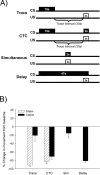Trace conditioning and the hippocampus: the importance of contiguity
- PMID: 16928858
- PMCID: PMC3289537
- DOI: 10.1523/JNEUROSCI.1742-06.2006
Trace conditioning and the hippocampus: the importance of contiguity
Abstract
Trace conditioning, a form of classical conditioning in which the presentation of the conditioned stimulus (CS) and the unconditioned stimulus (US) is separated in time by an interstimulus interval, requires an intact hippocampus. In contrast, classical conditioning procedures in which the CS and US are not separated by an interstimulus interval (i.e., delay conditioning procedures) typically do not (Solomon et al., 1986). However, why trace conditioning is dependent on the hippocampus is unknown. Several theories suggest that it is specifically the discontiguity between the CS and US in trace conditioning that critically engages the hippocampus. However, there are other explanations that do not depend on discontiguity. To determine whether the lack of contiguity renders trace conditioning hippocampal dependent, we designed a "contiguous trace conditioning" (CTC) paradigm in which CS-US contiguity is restored by re-presenting the CS simultaneously with the US. Although rats with excitotoxic lesions of the hippocampus could not learn a standard trace fear-conditioning paradigm, lesioned rats trained on CTC showed significant conditioning, at levels similar to those with sham surgeries. Importantly, lesioned rats trained solely with simultaneous CS-US presentations did not demonstrate conditioning. Together, these data suggest that rats with hippocampal lesions can form a memory of a trace CS-US association when contiguity is restored. Therefore, the dependence of traditional trace paradigms on the hippocampus can be attributed to the absence of temporal contiguity.
Figures


References
-
- Anagnostaras SG, Gale GD, Fanselow MS. Hippocampus and contextual fear conditioning: recent controversies and advances. Hippocampus. 2001;11:8–17. - PubMed
-
- Beylin AV, Gandhi CC, Wood GE, Talk AC, Matzel LD, Shors TJ. The role of the hippocampus in trace conditioning: temporal discontinuity or task difficulty? Neurobiol Learn Mem. 2001;76:447–461. - PubMed
-
- Bolles RC, Collier AC, Bouton ME, Marlin NA. Some tricks for ameliorating the trace-conditioning deficit. Bull Psychon Soc. 1978;11:403–406.
-
- Clark RE, Squire LR. Classical conditioning and brain systems: the role of awareness. Science. 1998;280:77–81. - PubMed
-
- Clark RE, Squire LR. The importance of awareness for eyeblink conditioning is conditional: theoretical comment on Bellebaum and Daum. Behav Neurosci. 2004;118:1466–1468. - PubMed
Publication types
MeSH terms
Grants and funding
LinkOut - more resources
Full Text Sources
Other Literature Sources
